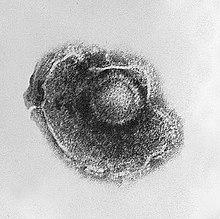Alphaherpesvirinae
| Alphaherpesvirinae | |
|---|---|

| |
| Electron micrograph of a Human alphaherpesvirus 3 virion | |
| Virus classification | |
| (unranked): | Virus |
| Realm: | Duplodnaviria |
| Kingdom: | Heunggongvirae |
| Phylum: | Peploviricota |
| Class: | Herviviricetes |
| Order: | Herpesvirales |
| Family: | Orthoherpesviridae |
| Subfamily: | Alphaherpesvirinae |
| Genera | |
|
See text | |
Alphaherpesvirinae is a subfamily of viruses in the family Herpesviridae, primarily distinguished by reproducing more quickly than other subfamilies in the Herpesviridae. In animal virology the most important herpesviruses belong to the Alphaherpesvirinae. Pseudorabies virus is the causative agent of Aujeszky's disease in pigs and Bovine herpesvirus 1 is the causative agent of bovine infectious rhinotracheitis and pustular vulvovaginitis.[1][2] Mammals serve as natural hosts. There are currently 45 species in this subfamily, divided among 5 genera with one species unassigned to a genus. Diseases associated with this subfamily include: HHV-1 and HHV-2: skin vesicles or mucosal ulcers, rarely encephalitis and meningitis, HHV-3: chickenpox (varicella) and shingles, GaHV-2: Marek's disease.[3][4]
Genera
Alphaherpesvirinae consists of the following five genera:[4]
The species Chelonid alphaherpesvirus 6 is currently unassigned to a genus.[4]
Structure
Viruses in Alphaherpesvirinae are enveloped, with icosahedral, spherical to pleomorphic, and round geometries, and T=16 symmetry. The diameter is around 150-200 nm. Genomes are linear and non-segmented, around 120 to 180 kb in length.[3]
| Genus | Structure | Symmetry | Capsid | Genomic arrangement | Genomic segmentation |
|---|---|---|---|---|---|
| Iltovirus | Spherical pleomorphic | T=16 | Enveloped | Linear | Monopartite |
| Mardivirus | Spherical pleomorphic | T=16 | Enveloped | Linear | Monopartite |
| Simplexvirus | Spherical pleomorphic | T=16 | Enveloped | Linear | Monopartite |
| Scutavirus | Spherical pleomorphic | T=16 | Enveloped | Linear | Monopartite |
| Varicellovirus | Spherical pleomorphic | T=16 | Enveloped | Linear | Monopartite |
Life cycle
Viral replication is nuclear, and is lysogenic. Entry into the host cell is achieved by attachment of the viral gB, gC, gD and gH proteins to host receptors, which mediates endocytosis. Replication follows the dsDNA bidirectional replication model. DNA-templated transcription, with some alternative splicing mechanism is the method of transcription. Translation takes place by leaky scanning. The virus exits the host cell by nuclear egress, budding, and microtubular outwards viral transport. Mammals serve as the natural host. Transmission routes are sexual, contact, body fluids, lesions, and respiratory.[3]
| Genus | Host details | Tissue tropism | Entry details | Release details | Replication site | Assembly site | Transmission |
|---|---|---|---|---|---|---|---|
| Iltovirus | Birds: galliform: psittacine | None | Cell receptor endocytosis | Budding | Nucleus | Nucleus | Oral-fecal; aerosol |
| Mardivirus | Chickens; turkeys; quail | None | Cell receptor endocytosis | Budding | Nucleus | Nucleus | Aerosol |
| Simplexvirus | Humans; mammals | Epithelial mucosa | Cell receptor endocytosis | Budding | Nucleus | Nucleus | Saliva |
| Scutavirus | Sea turtles | None | Cell receptor endocytosis | Budding | Nucleus | Nucleus | Aerosol |
| Varicellovirus | Mammals | Epithelial mucosa | Glycoproteins | Budding | Nucleus | Nucleus | Aerosol |
References
- ^ Mettenleiter; et al. (2008). "Molecular Biology of Animal Herpesviruses". Animal Viruses: Molecular Biology. Caister Academic Press. ISBN 978-1-904455-22-6.
- ^ Sandri-Goldin RM., ed. (2006). Alpha Herpesviruses: Molecular and Cellular Biology. Caister Academic Press. ISBN 978-1-904455-09-7.
- ^ a b c "Viral Zone". ExPASy. Retrieved 12 June 2015.
- ^ a b c "Virus Taxonomy: 2020 Release". International Committee on Taxonomy of Viruses (ICTV). March 2021. Retrieved 10 May 2021.
External links
- Alphaherpesvirinae at the U.S. National Library of Medicine Medical Subject Headings (MeSH)
- Viralzone: Alphaherpesvirinae
- ICTV
- Animal Viruses
